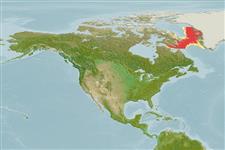Teleostei (teleosts) >
Perciformes/Zoarcoidei (Eelpouts and pricklebacks) >
Zoarcidae (Eelpouts) > Lycodinae
Etymology: Lycodes: Greek, lykos = wolf + Greek, suffix, oides = similar to (Ref. 45335).
Eponymy: Jens Laurentius Moestue Vahl (1796–1854) was a Danish botanist and pharmacist. [...] (Ref. 128868), visit book page.
Environment: milieu / climate zone / depth range / distribution range
Ecology
Marine; bathydemersal; depth range 39 - 1200 m (Ref. 117245), usually 71 - ? m (Ref. 117245). Deep-water; 0°C - 5°C (Ref. 35388); 74°N - 61°N, 72°W - 45°W (Ref. 117245)
Arctic to Northwest Atlantic: Canada to Greenland.
Size / Weight / Age
Maturity: Lm ? range ? - ? cm
Max length : 52.0 cm TL male/unsexed; (Ref. 4695); common length : 27.5 cm TL male/unsexed; (Ref. 4695)
Dorsal fin without depression, front end with 0-3 black - brown spots. Lateral line runs near the anal fin (Ref. 35388).
Lives at temperature of 0-5°C. Off Greenland it measures 50 cm and off Scandinavia rarely over 25-30 cm (Ref. 35388). Benthic (Ref. 58426). Feeds mostly on endobenthic prey, with shrimps and euphausiids becoming the more prominent prey as the size increases (Ref. 13532). Prefers warmer waters (Ref. 13534). Large eggs of 6 mm diameter are deposited on the sea floor.
Life cycle and mating behavior
Maturity | Reproduction | Spawning | Eggs | Fecundity | Larvae
Anderson, M.E., 1994. Systematics and osteology of the Zoarcidae (Teleostei: Perciformes). Ichthyol. Bull. J.L.B. Smith Inst. Ichthyol. 60:120 p. (Ref. 11954)
IUCN Red List Status (Ref. 130435: Version 2024-2)
Threat to humans
Harmless
Human uses
Fisheries: subsistence fisheries
Tools
Special reports
Download XML
Internet sources
Estimates based on models
Preferred temperature (Ref.
123201): 1.4 - 5.6, mean 3.2 °C (based on 263 cells).
Phylogenetic diversity index (Ref.
82804): PD
50 = 0.5000 [Uniqueness, from 0.5 = low to 2.0 = high].
Bayesian length-weight: a=0.00219 (0.00137 - 0.00348), b=3.18 (3.04 - 3.32), in cm total length, based on LWR estimates for this species & (Sub)family-body (Ref.
93245).
Trophic level (Ref.
69278): 3.4 ±0.42 se; based on food items.
Resilience (Ref.
120179): Very Low, minimum population doubling time more than 14 years (Preliminary K or Fecundity.).
Fishing Vulnerability (Ref.
59153): Moderate vulnerability (41 of 100).
